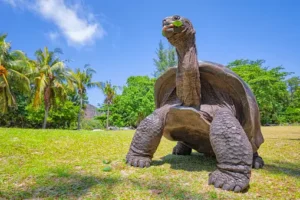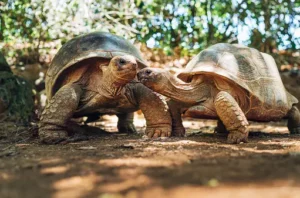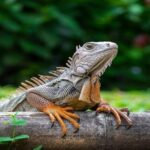Introduction to the Aldabra Giant Tortoise
The Aldabra Giant Tortoise (Aldabrachelys gigantean) stands as a captivating emblem of longevity and adaptation in the animal kingdom. Native to the Aldabra Atoll in the Seychelles, this species has garnered global attention for its remarkable size, longevity, and distinctive features. With a commanding presence, these tortoises are renowned for being among the largest terrestrial reptiles, often reaching lengths of over 4 feet and weighing up to an astonishing 550 pounds.

These tortoises have evolved unique traits to thrive in their specific habitat, which includes grasslands, mangrove swamps, and coastal dunes. Their domed shells, robust limbs, and sturdy necks exemplify their ability to navigate through various landscapes. Perhaps most striking is their impressive lifespan; Aldabra Giant Tortoises are known to live well over a century, with verified cases of individuals exceeding 200 years. This longevity has fueled fascination and spurred research into the mechanisms behind their slow aging process.
Aldabra Giant Tortoises are herbivorous grazers, primarily feeding on grasses, leaves, and woody plants. Their crucial role as seed dispersers contributes to the ecological balance of their environment. Despite their large size, these tortoises have managed to survive multiple threats, including habitat loss and invasive species, thanks in part to dedicated conservation efforts and protective measures.
Physical Characteristics and Size of Aldabra Giant Tortoises
The Aldabra Giant Tortoise (Aldabrachelys gigantean) is renowned for its impressive size and distinct physical attributes. These tortoises are among the largest land-dwelling reptiles, showcasing remarkable variations in size and appearance across their range. Generally, adults have a massive, dome-shaped carapace (shell) that can measure up to 4 feet (1.2 meters) in length and weigh over 500 pounds (227 kilograms). The carapace is primarily dark brown or black and features a unique shape that aids in protection and thermoregulation.

Their robust limbs and elephantine feet support their immense body weight, each foot ending in thick, sturdy claws that are well-suited for digging, gripping, and traversing their native terrain. These tortoises exhibit sexual dimorphism, with males being slightly larger and possessing longer, thicker tails than females.
Aldabra Giant Tortoises are well-adapted to their environment, with their high-domed shell providing a shield against potential threats and extreme temperatures. Additionally, their long necks aid in reaching vegetation for feeding, and their strong beaks are designed to grasp and consume various plant materials. Despite their colossal size, these tortoises are surprisingly agile and can navigate through various habitats, including grasslands and shrublands.
Observing these distinctive physical characteristics offers valuable insights into the evolutionary adaptations that have enabled Aldabra Giant Tortoises to thrive on the remote Aldabra Atoll and neighboring islands. As iconic representatives of island biodiversity, their physical traits and size contribute to their vital role within their ecosystem.
The Natural Habitat of Aldabra Giant Tortoises

The Aldabra Giant Tortoise (Aldabrachelys gigantean) is a remarkable reptile native to the Aldabra Atoll in the Seychelles, a remote group of islands in the Indian Ocean. This species has become synonymous with the unique ecosystem it inhabits. The natural habitat of Aldabra Giant Tortoises is characterized by the atoll’s distinctive environment, which comprises lush coastal areas, dense mangrove swamps, and low-lying forests.
Aldabra Atoll offers a diverse range of habitats for these tortoises. The coastal zones provide sandy nesting sites where the females lay their eggs, carefully selecting locations that offer protection against the harsh elements and potential predators. The dense mangrove areas serve as important shelters, offering refuge from extreme weather and aiding in regulating body temperature. The tortoises also venture into the lush forested regions, where they forage on a variety of vegetation.
The isolation of the Aldabra Atoll has contributed to the evolution of this giant tortoise species. With minimal human intervention, the tortoises have thrived in this unique ecosystem for centuries. However, introduced species, habitat loss, and climate change pose significant threats to their natural habitat and survival.
Understanding and preserving the natural habitat of Aldabra Giant Tortoises is paramount to their conservation. Efforts to protect this habitat include sustainable tourism practices, habitat restoration projects, and ongoing research to monitor the health of the ecosystem. By safeguarding their natural home, we can ensure the survival of these iconic and ancient creatures for generations to come.
Horned Lizard: 20 Most Important things For Pets Lover
Aldabra Giant Tortoise: Lifespan and Aging Process
The Aldabra Giant Tortoise (Aldabrachelys gigantean) is renowned for its exceptional lifespan and intriguing aging process. These majestic creatures, inhabiting the Aldabra Atoll in the Indian Ocean, have astounded scientists and nature enthusiasts alike with their longevity.
Aldabra Giant Tortoises are known to live for over a century, making them one of the longest-lived vertebrates on Earth. Some individuals have been documented to surpass even 200 years of age. This remarkable longevity is attributed to their slow metabolic rate, large body size, and relatively safe environment on the isolated atoll.
The aging process of these tortoises is intriguing. They exhibit indeterminate growth, meaning that they continue to grow throughout their lives. This growth contributes to the rings that can be observed on their shells, similar to tree rings. Counting these rings can provide a rough estimate of the tortoise’s age.
As they age, Aldabra Giant Tortoises undergo certain physiological changes. Their shells may become more worn and weathered, and their movements might slow down even further. However, their remarkable adaptability allows them to maintain relatively good health even in their later years.
Studying the lifespan and aging process of Aldabra Giant Tortoises provides valuable insights into the biology of longevity and the adaptations that enable these creatures to thrive over such extended periods. Their ability to survive and reproduce for decades upon decades showcases the beauty of nature’s longevity marvels.
Diet and Feeding Habits of Aldabra Giant Tortoises

The diet and feeding habits of Aldabra Giant Tortoises (Aldabrachelys gigantean) are integral to their survival and ecological role. These remarkable reptiles primarily inhabit the Aldabra Atoll in the Indian Ocean, where they’ve adapted to a diet mainly consisting of vegetation.
Aldabra Giant Tortoises are herbivores, meaning their diet consists primarily of plant material. They graze on grasses, leaves, shrubs, and fallen fruits. Their diet can vary based on the availability of these resources, which changes with seasonal and environmental factors. They are known for their ability to reach high vegetation by stretching their necks and legs, and they also use their strong, curved beaks to break down tougher plant matter.
This diet has a significant impact on the Aldabra ecosystem. The tortoises’ feeding behavior shapes the plant community by influencing the distribution and abundance of plant species. Their browsing helps control the growth of certain plants, allowing other vegetation to flourish. Additionally, their movement patterns while foraging disperse seeds across the island, aiding in plant propagation.
Interestingly, Aldabra Giant Tortoises have been observed displaying selective feeding preferences. They may favor certain types of plants or parts of plants over others. This behavior has implications for the overall plant diversity on the atoll.
In conservation efforts, understanding their diet and feeding habits is crucial. Anthropogenic activities and invasive species can disrupt the natural vegetation, affecting the tortoises’ food sources. By preserving their habitats and ensuring the availability of suitable vegetation, we can help sustain the Aldabra Giant Tortoise population and the delicate ecosystem they are an integral part of.
Reproduction and Breeding Behavior of Aldabra Giant Tortoises
The reproduction and breeding behavior of Aldabra Giant Tortoises (Aldabrachelys gigantean) offer fascinating insights into their unique lifecycle. These tortoises, endemic to the Aldabra Atoll in the Indian Ocean, exhibit distinctive reproductive traits that have evolved in response to their isolated island environment.

Aldabra Giant Tortoises typically reach sexual maturity around 20 to 25 years of age, although this can vary based on factors such as diet and environmental conditions. Mating rituals often involve elaborate displays by males, including hissing, stretching their necks, and circling prospective mates. Dominance among males is established through size and strength, and contests may arise between rivals.
Female Aldabra Giant Tortoises lay their eggs in carefully selected sandy nests, which they dig using their powerful legs. The nesting sites are crucial for ensuring the survival of the eggs, protecting them from potential predators. After laying, females cover the eggs with soil and leave them to incubate naturally. The temperature within the nest determines the sex of the offspring, with warmer temperatures leading to females and cooler temperatures resulting in males.
The incubation period varies but can last several months. Upon hatching, the young tortoises face challenges as they emerge from the nest and begin their journey in a world filled with potential dangers. Their survival depends on their ability to find shelter, food, and avoid predators.
The Aldabra Giant Tortoise’s unique reproductive and breeding behaviors reflect their long adaptation to the isolated and diverse ecosystem of the Aldabra Atoll. Understanding these behaviors not only provides insights into the tortoises’ biology but also contributes to ongoing conservation efforts aimed at preserving their delicate and intriguing way of life.
Conservation Status and Threats to Aldabra Giant Tortoises
The conservation status of Aldabra Giant Tortoises (Aldabrachelys gigantean) is a matter of concern due to various threats that have led to population declines in their native habitats. These remarkable creatures, endemic to the Aldabra Atoll in the Seychelles, face an array of challenges that endanger their survival.
One of the primary threats to Aldabra Giant Tortoises is habitat degradation caused by invasive plant species, which compete for resources and disrupt the tortoises’ natural feeding and nesting grounds. Additionally, habitat loss due to human activities such as urbanization and tourism development has further encroached upon their living space.
Historically, these tortoises were exploited by sailors and traders for their meat, contributing to their decline. Although such direct exploitation has diminished, they still face risks from poaching for their shells and the illegal pet trade.
Climate change poses a significant threat, as rising temperatures can impact tortoise nesting sites and alter their food availability. Moreover, changes in precipitation patterns may affect the availability of freshwater sources, vital for the tortoises’ survival.
Establishing protected areas, managing invasive species, and promoting responsible tourism practices are steps being taken to safeguard these tortoises. Captive breeding programs have also been instrumental in bolstering population numbers and providing individuals for potential reintroduction into the wild.
Albatross: 10 Interesting Things
Interaction with Humans: Historical and Cultural Significance

The Aldabra Giant Tortoise holds profound historical and cultural significance due to its enduring interaction with humans. For centuries, these majestic creatures have been integral to the livelihoods and beliefs of various societies. In the 18th century, sailors and explorers visiting the remote Aldabra Atoll found sustenance in the form of tortoise meat, as these creatures could survive without food or water for extended periods.
Beyond sustenance, Aldabra Giant Tortoises became emblematic in cultural narratives. In some cultures, they were revered as symbols of longevity, wisdom, and even creation. The giant tortoise’s ponderous yet steady nature inspired tales of perseverance and the passage of time.
Regrettably, historical interactions also carried negative implications. The immense size and docility of the tortoises made them easy targets for exploitation, leading to drastic population declines. Sailors and traders captured them for food, while introduced species brought by humans disrupted their habitats.
Today, the cultural significance of Aldabra Giant Tortoises remains a driving force in conservation efforts. Communities, scientists, and organizations collaborate to protect and restore their habitats, ensuring that these remarkable creatures continue to inspire awe, respect, and understanding in the modern world.
Unique Behaviors and Adaptations of Aldabra Giant Tortoises
Aldabra Giant Tortoises exhibit a range of unique behaviors and adaptations that have enabled them to thrive in their native habitat. One remarkable adaptation is their ability to store water and survive for extended periods without drinking. These tortoises can absorb water from succulent plants and store it in their bladders, allowing them to endure drought conditions.
Another fascinating behavior is their basking ritual, where they position themselves in open areas to absorb heat from the sun. This behavior aids in thermoregulation, maintaining their body temperature and overall metabolism. Their slow movement might seem like a disadvantage, but it serves as an effective energy conservation strategy in their low-resource environment.
Socially, Aldabra Giant Tortoises display hierarchical behaviors, particularly among males competing for dominance. They engage in head-bobbing displays, hissing, and even aggressive pushing matches to establish dominance.
Their adaptations also extend to feeding habits, as they consume a diverse diet including grasses, shrubs, and fallen fruits. This flexibility allows them to adjust their diet based on food availability. Their sturdy, dome-shaped shells offer protection against predators, while their long necks enable them to reach vegetation that might otherwise be inaccessible.
Comparing Aldabra Giant Tortoises to Other Giant Tortoise Species
Aldabra Giant Tortoises (Aldabrachelys gigantean) stand as remarkable representatives of the tortoise world, known for their unique features and intriguing differences from other giant tortoise species. One key distinction lies in their native habitat; Aldabra tortoises are exclusively found on the remote Aldabra Atoll in the Indian Ocean, setting them apart from their relatives who inhabit various islands in the Galápagos and Seychelles archipelagos.
Physically, Aldabra giants showcase a colossal size, with some individuals weighing over 500 kilograms and measuring up to 120 centimeters in length. This distinguishes them from the smaller Galápagos species and the Seychelles’ iconic species, the Seychelles Giant Tortoise. Furthermore, Aldabra tortoises possess a unique domed shell shape, differing from the flatter shells seen in some Galápagos tortoises.
In terms of behavior, Aldabra giants tend to exhibit a more relaxed and sedentary lifestyle compared to their counterparts, possibly influenced by their abundant food sources on the Aldabra Atoll. In contrast, Galápagos tortoises often display more varied movement patterns due to the diverse environments they inhabit.
Despite these variations, all giant tortoise species play pivotal roles in their ecosystems as seed dispersers and ecosystem engineers. While each species has its own story to tell, the Aldabra Giant Tortoise’s isolation and distinct traits continue to captivate researchers and enthusiasts alike.
Ecological Impact: Aldabra Giant Tortoises as Keystone Species

The Aldabra Giant Tortoise, endemic to the Aldabra Atoll in the Indian Ocean, plays a pivotal role in its ecosystem as a keystone species. These tortoises have a profound ecological impact, shaping the landscape and influencing various species around them.
Their foraging behavior helps maintain the vegetation in check, preventing overgrowth that could threaten other plant and animal species. By consuming a variety of plants, the tortoises indirectly contribute to seed dispersal, aiding in the propagation of different plant species.
Moreover, their burrowing activities create essential habitats for other creatures, such as nesting birds and small mammals, offering protection from harsh environmental conditions and predators. The depressions formed by their burrows also serve as water reservoirs during dry periods, supporting the survival of multiple organisms.
Aldabra Giant Tortoises’ grazing and movement patterns have sculpted the terrain over centuries, shaping the composition and distribution of plant communities. The interconnected relationships they foster underscore their significance as a keystone species, influencing the dynamics of Aldabra’s intricate ecosystem. Recognizing and preserving the role of these tortoises is crucial for maintaining the delicate balance of this unique habitat.
Airedale Terrier: 12 Interesting Fats
Conservation Efforts and Captive Breeding Programs
Conservation efforts and captive breeding programs play a pivotal role in safeguarding the Aldabra Giant Tortoise, a remarkable species facing various challenges. Due to habitat loss, invasive species, and other human-induced factors, these tortoises are categorized as vulnerable by conservation organizations. To counteract this decline, dedicated initiatives have been established.
Captive breeding programs are central to the conservation strategy. Specialized facilities recreate optimal conditions for breeding, incubation, and hatchling care. These programs not only boost population numbers but also help maintain genetic diversity, crucial for the species’ long-term survival. Furthermore, efforts are underway to reintroduce captive-bred tortoises into their natural habitat, bolstering wild populations.
Conservation efforts extend beyond breeding. Ecosystem restoration and management are critical aspects. Protecting Aldabra Atoll—their primary habitat—is vital, involving eradication of invasive species and habitat restoration. Collaborative projects between conservation organizations, governments, and local communities are promoting sustainable practices and raising awareness.
The Aldabra Giant Tortoise’s endurance relies on a multifaceted approach. By coupling captive breeding programs with habitat preservation, invasive species control, and community engagement, we can aspire to secure a future for these ancient and captivating creatures on both Aldabra Atoll and beyond.
Studying Aldabra Giant Tortoises: Scientific Research and Discoveries
Studying Aldabra Giant Tortoises has led to a wealth of scientific research and remarkable discoveries. These iconic reptiles, endemic to the Aldabra Atoll in the Indian Ocean, have captured the curiosity of researchers worldwide. Through careful observation and advanced technology, scientists have unveiled essential aspects of their biology and ecology.
Researchers have delved into the tortoises’ longevity, uncovering insights into their impressive lifespans, with some individuals living well over a century. Moreover, studies have shed light on their feeding habits, revealing how they adapt to their environment and the crucial role they play in shaping their ecosystem as herbivores.
The tortoises’ reproductive behavior has also fascinated scientists, who have documented their unique courtship rituals and nesting habits. These studies contribute to our understanding of their conservation needs and aid in developing effective management strategies.
Cutting-edge techniques such as DNA analysis have unveiled the genetic diversity within the population, aiding in conservation efforts and highlighting the importance of preserving these ancient creatures.
In conclusion, scientific research centered on Aldabra Giant Tortoises continues to yield insights that extend beyond the tortoises themselves. By enhancing our understanding of these remarkable animals, we gain valuable knowledge about evolutionary biology, island ecology, and the broader significance of safeguarding Earth’s biodiversity.
Tourist Attractions and Responsible Tourism Involving Tortoises

Tourist attractions featuring Aldabra Giant Tortoises offer a captivating opportunity to observe these magnificent creatures in their natural habitat. The Aldabra Atoll, a UNESCO World Heritage Site in the Seychelles, stands as a prime example of responsible tourism focused on these tortoises. Managed with utmost care, the site offers visitors a chance to witness the tortoises’ impressive size and gentle demeanor, all while adhering to strict guidelines to ensure the tortoises’ well-being and conservation.
Responsible tourism involves minimizing human impact on these sensitive ecosystems. Visitors are educated about maintaining a respectful distance, refraining from feeding the tortoises, and not disturbing their habitats. Guided tours by knowledgeable naturalists further enhance the experience, providing insights into the tortoises’ behavior, biology, and the vital role they play in the ecosystem.
By supporting responsible tourism initiatives, visitors contribute to the conservation of Aldabra Giant Tortoises and their habitat. The funds generated often directly fund conservation efforts, research projects, and educational programs aimed at raising awareness about the importance of these ancient creatures. Ultimately, responsible tourism not only benefits the tortoises but also enriches the lives of those fortunate enough to encounter these living relics of the past.
Folklore and Mythology: Symbolism of Aldabra Giant Tortoises in Local Traditions
In the folklore and mythology of many cultures, Aldabra Giant Tortoises have held profound symbolism and significance. These majestic creatures, with their slow and deliberate movements, have often been associated with themes of longevity, wisdom, and endurance.
In some indigenous beliefs, the tortoise’s long lifespan has rendered it a symbol of immortality and a bridge between the mortal and immortal realms. Its deliberate pace is often linked to patience, teaching humans the value of persistence and the rewards of steady effort.
Among certain cultures, the shell of the Aldabra Giant Tortoise has been revered as a sacred object embodying protection and strength. This symbolism extends to spiritual practices where the tortoise shell is used as a divination tool or worn as an amulet for safeguarding against negative energies.
Legends featuring these tortoises frequently emphasize their role as keepers of ancient wisdom and the ability to withstand the test of time. Their presence in stories often imparts lessons about respecting nature and valuing the interconnectedness of all living beings.
Incorporating Aldabra Giant Tortoises into local traditions underscores their enduring influence on human perspectives, offering a glimpse into the intricate relationship between nature, symbolism, and cultural heritage.
FAQ’s:
What is the unique feature of Aldabra Giant Tortoises that sets them apart from other tortoise species?
One distinctive feature of Aldabra Giant Tortoises is their impressive size, making them one of the largest tortoise species in the world. They also have a distinctive saddle-shaped shell and a long neck that helps them reach vegetation at various heights.
Where can Aldabra Giant Tortoises be found in the wild?
Aldabra Giant Tortoises are native to the Aldabra Atoll in the Seychelles, an archipelago in the Indian Ocean. This remote and isolated habitat has contributed to the unique evolution of this species.
How long do Aldabra Giant Tortoises typically live?
Aldabra Giant Tortoises are known for their remarkable longevity. In the wild, they can live well over 100 years, with some individuals even reaching ages of 150 years or more. In captivity, they can have similarly extended lifespans.
What do Aldabra Giant Tortoises eat in their natural habitat?
Aldabra Giant Tortoises are herbivores, primarily feeding on a variety of plant matter such as grasses, leaves, and fruits. Their diet varies depending on the availability of vegetation in their habitat.
Are Aldabra Giant Tortoises endangered, and what efforts are being made to conserve them?
While Aldabra Giant Tortoises are currently listed as “vulnerable” rather than “endangered,” they face threats from habitat destruction, introduced species, and climate change. Conservation efforts include protecting their natural habitat, implementing captive breeding programs, and closely monitoring their populations to ensure their survival.


